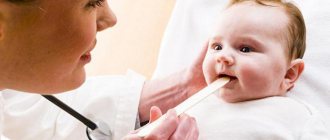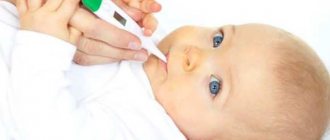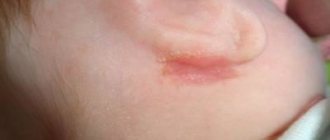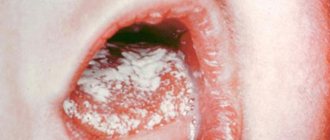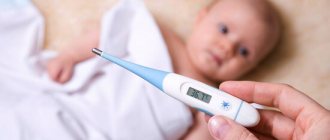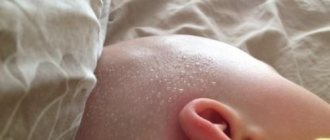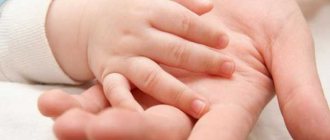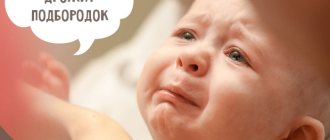What does healthy baby stool look like?
The baby's bowel movements depend on the type of feeding. A baby's first stool is called meconium. It is usually dark in color with a greenish tint. Meconium appears during the first two to three days of life.
When breastfeeding, a baby's normal stool has the following characteristics:
- Consistency ranges from creamy to liquid.
- Color from yellow to greenish.
- The smell is sour milk.
- There may be traces of undigested milk.
- The number of bowel movements ranges from 1 to 7. Usually after each feeding.
With artificial feeding, the stool is mushy, with the usual smell of feces.
What should a baby's stool look like?
During the first 3-4 days after birth, your baby's digestive system secretes a special substance called meconium, which is dark green in color and has a thick, sticky texture.
Normal stool in breastfed babies resembles porridge - a homogeneous substance of light brown or yellow color. Small quark-type particles are also visible in the stool and are not found in formula-fed babies.
Diarrhea is difficult to detect in a child younger than 6–12 months. Diarrhea is frequent bowel movements. But in infants, bowel movements can occur very often:
- The first month of life - the child defecates after each feeding 8-10 times a day;
- The second month of life - bowel movements less often, 5-6 times a day.
- The third to sixth month - 2-3 times a day, while the baby’s stool is darker and thicker.
The stool of bottle-fed babies has a thicker consistency and a stronger odor. The stool resembles that of an adult.
Signs of diarrhea
The manifestations of diarrhea in infants with breastfeeding and artificial feeding are the same. The child's behavior may change, and the number of bowel movements noticeably increases. What does diarrhea look like in a baby:
- the color of the stool changes, stool may become green or unnaturally yellow;
- the consistency may become noticeably thinner, down to water;
- there is mucus and blood in the stool;
- unpleasant “rotten” smell of stool.
The listed signs of diarrhea in a breastfeeding baby may be accompanied by fever, vomiting, and increased gas production. The child’s behavior indicates pain in the abdomen: the baby begins to be capricious and tuck his legs. It is important to distinguish vomiting from regurgitation. The latter happens after feeding or excessive activity. Vomit, on the contrary, comes out with pressure, a fountain, vomiting occurs spontaneously and is not associated with the feeding regimen.
Causes of diarrhea in babies
To understand what to do if a baby has diarrhea, it is necessary to determine its causes. A pediatrician can do this. The most common causes of diarrhea in infants during breastfeeding include:
- Changes in the diet of a nursing woman: eating fatty foods, large amounts of fresh vegetables and fruits, dairy products.
- Lactose or gluten intolerance in newborns. If there is a lack of digestive enzymes in the baby's stomach, diarrhea may occur. This happens if the mother’s menu includes products to which the baby is allergic: milk or cereal products.
- Reaction to a new product that a nursing woman introduced to her menu.
Yellow diarrhea in a baby caused by changes in the mother's diet goes away quickly and does not require special treatment. After restoring the diet, the digestion process returns to normal. Among the main causes of diarrhea in a bottle-fed baby, as a rule, are the addition of a new formula for feeding, as well as a premature transition to natural milk.
When complementary foods are introduced, the child's digestive system adapts to new, more complex foods. The color and consistency of the stool changes, it becomes more formed, and acquires a characteristic odor. Diarrhea in a mixed-fed baby can be a response of the body to the introduction of complementary foods - the digestive system is just adapting to such food, so it will take time for the baby’s gastrointestinal tract to function normally.
The digestive system of an infant continues to develop in the first months of life. During this period, she is especially vulnerable to viruses and microbes that can cause serious illnesses accompanied by diarrhea.
Infectious causes of diarrhea
Green diarrhea in an infant indicates intestinal dysbiosis and the presence of pathogenic microflora.
Diarrhea may be caused by:
- bacterial intestinal infections, for example, salmonellosis, ischerichiosis;
- viral infections, such as rotavirus.
Despite the fact that parents carefully keep the house clean and sterilize pacifiers and dishes, the child still remains vulnerable to intestinal infections. Infection can occur as a result of contact with sick people and their things, or by eating fruits and vegetables that are not washed well enough.
A sign of an intestinal infection, in addition to diarrhea with mucus, in infants is general intoxication of the body. It is accompanied by fever, vomiting, chills, and headache. Manifestations may vary depending on the severity of the disease. Sometimes a baby vomits without fever or diarrhea.
Rotavirus
Rotavirus is a viral disease that is especially dangerous for children under one year of age. Manifestations of the disease are similar to food poisoning and intestinal infection. The main danger is associated with dehydration, which can threaten the baby's life.
Treatment of diarrhea in infants
Treatment of diarrhea in newborns is accompanied by adjustments to the diet of both mother and child. It is necessary to exclude from the diet all foods that can cause intestinal upset - fatty foods, milk. If your baby is formula-fed, it may need to be replaced with an adapted formula.
Mothers are advised to introduce new foods into their diet gradually, carefully observing the baby's reaction. This will help rule out common problems such as poor bowel movements or constipation in your baby.
In some cases, the normalization of the digestive system is carried out with drugs selected by a pediatrician. These drugs include Nifuroxazide, Furazolidone.
Self-administration of any medications is completely prohibited; only a pediatrician can prescribe medications for diarrhea after an initial examination of the baby.
Women who are breastfeeding, mother or child treated with antibacterial drugs, need to take drugs that normalize the intestinal microflora - Bifidumbacterin, Lactobacilli, Enterofuril. These measures effectively increase the number of beneficial lactic acid bacteria and normalize the functioning of the digestive system of children.
Parents should not worry about the child’s body’s reaction to antibiotics; the development of dysbiosis is considered normal. It is enough to give the child sorbents that increase the activity of beneficial bacteria in the intestinal cavity, and a large amount of liquid to prevent problems with bowel movements.
Treatment of diarrhea in newborns
When the first signs of diarrhea appear, you should immediately consult a doctor. Based on the diagnosis, the pediatrician will determine how to treat diarrhea in an infant. The main task of parents is to prevent disruption of the water-salt balance in the baby’s body. The following measures are aimed at this:
- continuation of natural feeding at the request of the newborn;
- drinking water from a spoon in small, frequent portions;
- the use of drugs that help maintain the body’s water-salt balance;
- taking antiviral drugs, sorbents, as well as drugs aimed at restoring the normal functioning of the newborn’s intestines.
Diarrhea in an infant should never be ignored, as its consequences can be serious. In case of severe diarrhea, it is necessary to contact a specialist on the first day of the disease.
What to do if your baby has a cold
The treatment of acute respiratory viral infections in newborns should have an integrated approach, which includes improving the child’s nasal breathing, controlling body temperature, combating toxicosis, and also influencing the causative agents of the disease.
The main symptoms of a cold in infants are:
- nasal congestion and excessive discharge,
- increase in body temperature,
- lethargy,
- poor appetite
- sleep disturbance,
- anxiety,
- disruption of the gastrointestinal tract,
- cough,
- sore throat and breathing problems.
Each of these signs can manifest itself to varying degrees. Very young children do not know how to sneeze and cough, nor do they know how to blow their nose on their own. If the baby has a cold, parents need to regularly clean the baby's nose using an aspirator in the form of a bulb, tube or electronic device. This will not only make breathing easier, but also reduce the risk of complications, infection in the throat, bronchi, and improve the baby’s well-being. The main thing is to clean the newborn’s nose as carefully as possible so as not to damage the delicate mucous membrane.
If a child has ARVI, wet clean the children's room every day and ventilate it more often. In the cold season, it is better to postpone walks until the main symptoms of the disease disappear; water procedures should also be kept to a minimum - wash the baby in the shower as soon as it gets dirty. In the room of a cold baby, the temperature should be no higher than 220C, and the humidity should be no less than 60%.
Don't try to force-feed children if they don't want to, but you should give them something to drink more often. It is better if it is plain water without added sugar.
Do not mindlessly follow traditional medicine recipes and try to instill breast milk into your child’s nose. It is an excellent breeding ground for germs and can lead to additional health problems. If necessary, you can rinse your baby's nasal passages and use drops with an antiseptic or vasoconstrictor effect, which the pediatrician will recommend.
If the body temperature rises above 380C, the child should be given an antipyretic drug, also after consulting with a doctor. Under no circumstances should you rub your baby’s body with vinegar or alcohol – substances easily penetrate the body through enlarged skin pores and can cause irreparable harm to the baby. To alleviate the child’s condition, you can wipe his legs, arms, tummy, and neck with plain warm water.
Antiviral drugs will help speed up the recovery process and can also be used to prevent ARVI. The main task of parents is to select medications that can be used to treat and prevent colds in newborns. One of these drugs is the antiviral drug VIFERON, which has a wide spectrum of antiviral activity. Alpha-2b interferon, which is part of the drug, was created on the basis of modern technologies. Antiviral properties allow it to block the reproduction of the virus, and the immunomodulatory effect helps restore immunity. VIFERON preparations were developed as a result of fundamental research in the field of immunology, which proved that in the presence of antioxidants (vitamins C, E and others), the antiviral effect of interferon is enhanced.
The drug VIFERON Candles (suppositories) can be used to treat children from the first days of life. Premature newborns with a gestational age of less than 34 weeks are prescribed Viferon 150,000 IU, 1 suppository 3 times a day after 8 hours every day for 5 days. According to clinical indications, therapy can be continued. The break between courses is 5 days.
Children under 7 years old, incl. newborns and premature infants with a gestational age of more than 34 weeks are prescribed VIFERON Suppositories (suppositories) 150,000 IU, 1 suppository 2 times a day after 12 hours every day for 5 days. According to clinical indications, therapy can be continued. The break between courses is 5 days.
You can also use VIFERON Gel to combat acute respiratory infections. This drug can also be used to treat children from the first days of life. It is necessary to apply a strip of gel approximately 0.5 cm long to the nasal mucosa 3-5 times a day for 5 days. Before this, it is better to rinse the mucous membrane with saline solution. In order to protect a child from ARVI, it is necessary to apply a strip of gel approximately 0.5 cm long to the nasal mucosa 2 times a day as a preventive measure. Course duration is 2-4 weeks.

